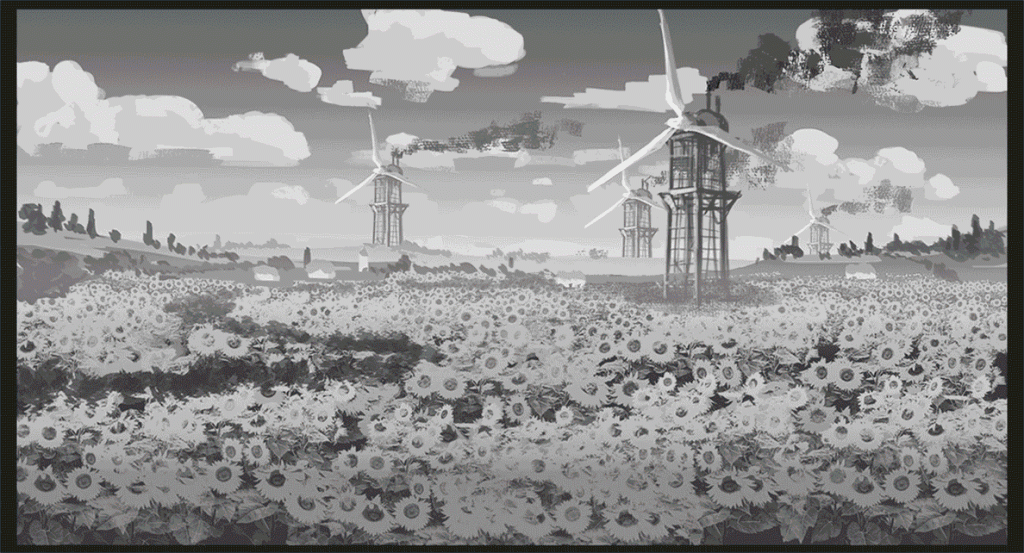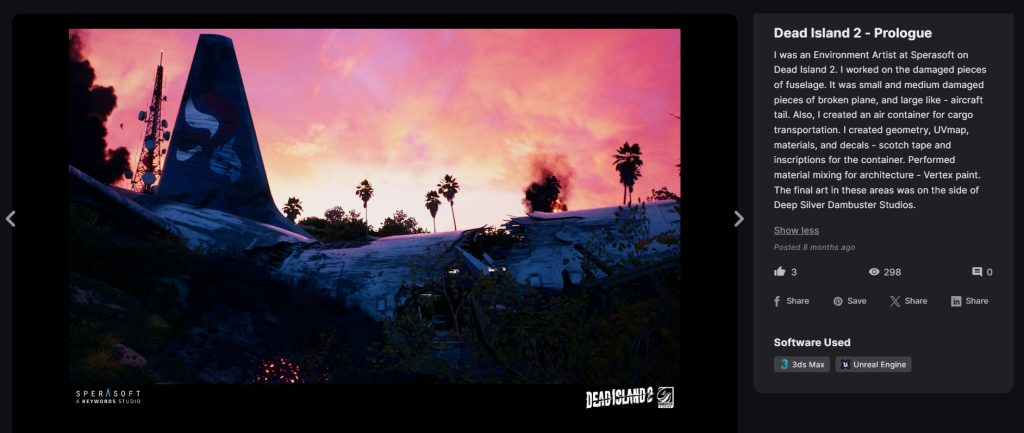3D Artist’s Portfolio Guide: From Good to Great
As we have some exciting growth, especially in our art team, it’s the perfect time to share some insider tips on creating a portfolio that stands out.
This advice is based on what catches our eye, but we’re sure it’ll be helpful for anyone who’s applying to any art-related job.
Our teammates have shared best practices that will help you show the whole range of your skills. Meet these guys:
- Oleksandr, Principal Environment Artist
- Oleksii, Lead Environment Artist
- Oleksandr, Weapon Artist
- Oleksandr, Vegetation Artist
- Dmytro, Material Artist
Let’s dive in!
1. Hard Skills: Priority #1
Oleksandr, Principal Environment Artist:
“When we’re looking for new people to join our team, first of all, we check out their hard skills. Some tasks require a mix of skills like modeling, texturing and sculpting. If someone can make fabric flow nicely or craft surfaces that look great, they’re exactly who we need.
At VG, we have roles ranging from general Environment/3D art to niche areas like Weapons or Surface art, still, we all do modeling. We’re always ready to help our teammates with other tasks, so it’s a big plus if you’re skilled in different areas. That’s why we recommend showing various works in your portfolio.”



2. Work Quantity: A Perfect Minimum
Oleksii, Lead Environment Artist:
“To see a specialist’s capabilities, we need to see several pieces of their work:
- For Junior artists, that means at least five small pieces. Alternatively, they may demonstrate a whole scene created in Unreal Engine, pointing out their contributions.
- Middle+ level specialists should demonstrate a range of experience. No matter if they have worked on several projects or just one. They should have a set of works that highlight their professional development and skills. Btw, it’s fine to include pieces from suspended or canceled projects. One might keep them in a private portfolio to show at interviews.
- For Senior specialists, the bar is set higher. They should have a track record of several released projects, ideally internationally known ones. Their portfolio should display not only their personal work but also the major projects they’ve been a part of.”

3. Work Quality: What to Show
Oleksandr: “While public platforms are ok for only top-notch artwork, showing drafts, basic models, and sketches at job interviews is a smart move. Even if you’ve followed online tutorials and created something you’re not ready to share publicly, don’t hide it away. Keep it privately on Google Drive or somewhere and share the link with future employers. Such works might not be perfect, but they still show us your strengths and potential for growth.”

4. Work Relevance: Your Most Recent Skill Level
Oleksii: “If you’re new to the industry, regularly updating your portfolio can boost your job search. It lets potential employers track your skill progression by comparing your latest works with older ones. So, don’t forget to add your most recent art to the top, let it grab attention right away.”
Oleksandr: “When you post your artwork on Artstation, focus on showcasing your best and newest works. If you share something not quite cool, people will judge your capabilities based on it. However, that only relates to your fresh art, not the stuff you created when you were just starting your career.”
5. Work Variety: From Organic to Weapons
At VG, we’ve got some specialized roles like Weapon, Vegetation or Material Artists, each with their own set of tasks (we’ll tell you more about that closer to the article’s end). Then there are roles like Environment Artist, where you’re expected to perform a variety of tasks. Yet for everyone, having a mix of different works in a portfolio is always a bonus.


Oleksii: “Here’s what I’d recommend to people who work in different areas:
- Vegetation artists should have relevant artwork, showcasing sculpting skills and knowledge of ZBrush or similar tools. This shows a strong interest in creating organic art and a solid skill set.
- Hard surface artists’ portfolios, on the other hand, should be full of architecture, props, and specific locations designed for these items. Adding fabric and simulation work will be a plus.
- Weapon artists commonly have all kinds of weapons in their portfolios – knives, pistols, rifles, and grenades. Weapons are key, even if they have a mix of other works to show. Their style can vary from photorealistic to sci-fi and stylized.”

6. Proficiency in Multiple Programs
We commonly use tools like ZBrush, Blender, Autodesk Maya, 3ds Max, Substance 3D Painter, Substance 3D Designer, and Marvelous Designer.
But you don’t need to master all these at once! 🙂 Our key tool is Blender. Then we use ZBrush for sculpting and Substance Designer or Painter for texturing, and Houdini for modeling/animation. Also, if you use industry-standard tools like 3dMax or Maya, that works for us too! Still, check out the requirements for each vacancy, as they may vary.
But don’t rush to add dozens of apps to your resume if you’re not actually using them. Better focus on key software and don’t forget to specify which tools you used for the projects in your private portfolio or your work descriptions on Artstation.

7. Process and Final Work: A Complete View
Some of our team leaders are ok with seeing only the final piece of art along with the topology (geometry). However, including more details in the portfolio will surely be beneficial.
Oleksandr: “Show your ‘work in progress’ (WIP). Start with your initial concept, move on to the blockout, show the details, and wrap up with the final result. Feel free to add sketches or quick pieces from tutorials together with your polished work.”



8. Detailed Descriptions for Each Work
All our artists believe that detailed descriptions for pieces in the portfolio are a must-have. They not only showcase your technical skills but also reveal how you can work as part of a team.
Tell people the following:
- The overall project’s journey, including how long it took.
- Software used for its creation.
- Its goal or why you started it — whether to sharpen your skills, handle a task at work or something else.
- If it was a team project, like creating a level, specify your role and highlight your achievements.

9. Professional Platform Presence
Oleksii: “Artstation is the primary space for artists right now. It’s more than just a portfolio site; it’s a global community of artists.”
However, we don’t focus on the variety of websites you upload your work to. The key is to have one solid portfolio either on a special platform or on your personal Google Drive.
10. Soft Skills: Teamwork is Key
Even though your portfolio doesn’t show your soft skills, we’d love to know you better. You can highlight these skills in your cover letter or chat about them during an interview:
- Teamwork is crucial for us. Being open to feedback along with being flexible yet independent shows you’re a real team player. Being responsible and good at prioritizing tasks is super important, especially for remote work, which is an option at our studio.
- Playing games isn’t just for fun. It’s about analyzing every aspect of the game – the tech, visuals, strategies, and outlining ways to make things better. If you share some examples of how you’d improve something in a random game, that would be great!
- Also, knowing when to stop and take a break is key to balancing quality and effort. This ensures getting the best results without heading towards burnout. Finally, we want our team members to be happy and full of muse and inspiration!
11. Recommendations for Niche Fields:
Oleksandr, Weapon Artist: “When creating weapons for our project, artists may deal with both hard surfaces and other elements. However, this isn’t crucial because the level of sculpting required isn’t as high as it is for Character artists. It’s more of a bonus.”


Oleksandr, Vegetation Artist: “At VG, I use tools like SpeedTree and photo scanning. From my experience, the best results usually come from a mix of SpeedTree, sculpting and manual texturing in Painter. I’d recommend including both pure SpeedTree works and mixed ones in your portfolio to show off cool shapes and implementation. Having only generic plants in your portfolio won’t stand out. It won’t grab attention or let us see what you can do.”

Dmytro, Material Artist: “The role of a Material Artist encompasses two significant aspects. The first of which is without a doubt an artistic one. Ideally, candidates for this position should possess versatile skills. From crafting sleek, hard-surfaced Sci-Fi panels to capturing the essence of organic, natural formations, the range of materials to be created can vary widely. This implies proficiency across diverse artistic realms. By today’s standards, Substance Designer with its procedural approach is the go-to software for texture creation.
That being said not all challenges can be efficiently tackled procedurally. Sometimes it’s quicker to build complicated shapes in 2D graphic editors like Photoshop or model/sculpt something and then bake all the necessary information to continue working with it down the line. Occasionally, achieving a specific artistic style may require manual sculpting of the entire material. Finding the right equilibrium between swift procedural iterations and incorporating handcrafted elements is the key.

When reviewing an artist’s portfolio, I consistently focus on their proficiency in handling color and form. Tileable textures are quite common and it’s important to make sure that any repeating patterns don’t stand out too much. Including various render passes alongside the final material image can be beneficial, showcasing how different maps harmonize and contribute to the overall composition.

Once the artistic phase concludes, the technical aspect comes into play. Even with a dedicated Technical Artist on the team, understanding how your maps will be implemented to achieve the desired outcome remains crucial. Materials must function efficiently, and textures should accommodate diverse technical requirements. However, it’s not uncommon for companies to expect Material Artists to handle technical tasks as well, necessitating knowledge of shader implementation, texture packing, optimization, and so on. Moreover, there may be a need to oversee the texturing pipeline and develop tools to streamline production and minimize repetitive tasks.”

Wrapping Up
We hope you find these recommendations useful as you prepare for an effective job search!
Got your portfolio polished? Send it to us with your resume! We’re on the lookout for talented people!
Right now, we’re expanding our Art team and searching for a Lead Environment 3D Artist. The key task of this team will be to create a perfect location that draws players into the game world, ensuring an unforgettable experience. So, our team eagerly awaits your applications and portfolios!


